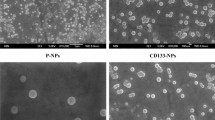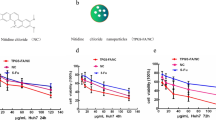Abstract
Recent studies have revealed the existence of liver cancer stem cells (CSCs). Therefore, there is an urgent need for new and effective treatment strategies specific to liver CSCs. In this work, the poly(d,l-lactide-coglycolide) nanoparticles containing paclitaxel were prepared by emulsification-solvent evaporation method. The nanoparticles decorated with anti-CD133 antibody, termed targeted nanoparticles, were prepared by carbodiimide chemistry for liver CSCs. The physicochemical characteristics of the nanoparticles (i.e., encapsulation efficiency, particle size distribution, morphology, and in vitro release) were investigated. Cellular uptake and accumulation in tumor tissue of nanoparticles were observed. To assess anti-tumor activity of nanoparticles in vitro and in vivo, cell survival assay and tumor regression study were carried out using liver cancer cell lines (Huh7 and HepG2) and their xenografts. Particle size of targeted nanoparticles was 429.26 ± 41.53 nm with zeta potential of −11.2 mV. Targeted nanoparticles possessed spherical morphology and high encapsulation efficiency (87.53 ± 5.9 %). The accumulation of targeted nanoparticles depends on dual effects of passive and active targeting. Drug-loaded nanoparticles showed cytotoxicity on the tumor cells in vitro and in vivo. Targeted nanoparticles resulted in significant improvement in therapeutic response through selectively eliminating CD133 positive subpopulation. These results suggested that the novel nanoparticles could be a promising candidate with excellent therapeutic efficacy for targeting liver CSCs.











Similar content being viewed by others
References
Brannon-Peppas L, Blanchette JO (2004) Nanoparticle and targeted systems for cancer therapy. Adv Drug Deliv Rev 56:1649–1659
Chakraborty M, Jain S, Rani V (2011) Nanotechnology: emerging tool for diagnostics and therapeutics. Appl Biochem Biotechnol 165:1178–1187
Chen H, Gao J, Lu Y et al (2008) Preparation and characterization of PE38KDEL-loaded anti-HER2 nanoparticles for targeted cancer therapy. J Control Release 128:209–216
Chen R, Nishimura MC, Bumbaca SM et al (2010) A hierarchy of self-renewing tumor-initiating cell types in glioblastoma. Cancer Cell 17:362–375
Duncan R (2003) The dawning era of polymer therapeutics. Nat Rev Drug Discov 2:347–360
Filippov S, Hrubý M, Konák C et al (2008) Novel pH-responsive nanoparticles. Langmuir 24:9295–9301
Garvalov BK, Acker T (2011) Cancer stem cells: a new framework for the design of tumor therapies. J Mol Med 89:95–107
Griffiths PC, Khayat Z, Tse S et al (2007) Studies on the mechanism of interaction of a bioresponsive endosomolytic polyamidoamine with interfaces. 1. Micelles as model surfaces. Biomacromolecules 8:1004–1012
Hashizume H, Baluk P, Morikawa S et al (2000) Openings between defective endothelial cells explain tumor vessel leakiness. Am J Pathol 156:1363–1380
Hobbs SK, Monsky WL, Yuan F et al (1998) Regulation of transport pathways in tumor vessels: role of tumor type and microenvironment. Proc Natl Acad Sci USA 95:4607–4612
Jin C, Bai L, Wu H et al (2007a) Radiosensitization of paclitaxel, etanidazole and paclitaxel + etanidazole nanoparticles on hypoxic human tumor cells in vitro. Biomaterials 28:3724–3730
Jin C, Wu H, Liu J et al (2007b) The effect of paclitaxel-loaded nanoparticles with radiation on hypoxic MCF-7 cells. J Clin Pharm Ther 32:41–47
Jin C, Bai L, Wu H et al (2008) Paclitaxel-loaded poly(d,l-lactide-co-glycolide) nanoparticles for radiotherapy in hypoxic human tumor cells in vitro. Cancer Biol Ther 7:911–916
Jin C, Bai L, Wu H et al (2009) Cytotoxicity of paclitaxel incorporated in PLGA nanoparticles on hypoxic human tumor cells. Pharm Res 26:1776–1784
Jin C, Qian N, Zhao W et al (2010) Improved therapeutic effect of DOX–PLGA–PEG micelles decorated with bivalent fragment HAb18 F(ab’)2 for hepatocellular carcinoma. Biomacromolecules 11:2422–2431
Kirpotin DB, Drummond DC, Shao Y et al (2006) Antibody targeting of long-circulating lipidic nanoparticles does not increase tumor localization but does increase internalization in animal models. Cancer Res 66:6732–6740
Llovet JM, Burroughs A, Bruix J (2003) Hepatocellular carcinoma. Lancet 362:1907–1917
Ma S, Chan KW, Hu L et al (2007) Identification and characterization of tumorigenic liver cancer stem/progenitor cells. Gastroenterology 132:2542–2556
McDonald DM, Baluk P (2002) Significance of blood vessel leakiness in cancer. Cancer Res 62:5381–5385
Oishi N, Wang XW (2011) Novel therapeutic strategies for targeting liver cancer stem cells. Int J Biol Sci 7:517–535
Rahbari NN, Mehrabi A, Mollberg NM et al (2011) Hepatocellular carcinoma: current management and perspectives for the future. Ann Surg 253:453–469
Richardson GD, Robson CN, Lang SH et al (2004) CD133, a novel marker for human prostatic epithelial stem cells. J Cell Sci 117:3539–3545
Scott CJ, Marouf WM, Quinn DJ et al (2008) Immunocolloidal targeting of the endocytotic siglec-7 receptor using peripheral attachment of siglec-7 antibodies to poly(lactide-co-glycolide) nanoparticles. Pharm Res 25:135–146
Smith LM, Nesterova A, Ryan MC et al (2008) CD133/prominin-1 is a potential therapeutic target for antibody-drug conjugates in hepatocellular and gastric cancers. Br J Cancer 99:100–109
Song W, Li H, Tao K et al (2008) Expression and clinical significance of the stem cell marker CD133 in hepatocellular carcinoma. Int J Clin Pract 62:1212–1218
Stephan MT, Moon JJ, Um SH et al (2010) Therapeutic cell engineering with surface-conjugated synthetic nanoparticles. Nat Med 16:1035–1041
Suetsugu A, Nagaki M, Aoki H et al (2006) Characterization of CD133+ hepatocellular carcinoma cells as cancer stem/progenitor cells. Biochem Biophys Res Commun 351:820–824
Swaminathan SK, Roger E, Toti U et al (2013) CD133-targeted paclitaxel delivery inhibits local tumor recurrence in a mouse model of breast cancer. J Control Release 171:280–287
Takayama T (2011) Surgical treatment for hepatocellular carcinoma. Jpn J Clin Oncol 41:447–454
Valencia PM, Hanewich-Hollatz MH, Gao W et al (2011) Effects of ligands with different water solubilities on self-assembly and properties of targeted nanoparticles. Biomaterials 32:6226–6233
Visvader JE (2011) Cells of origin in cancer. Nature 469:314–322
Visvader JE, Lindeman GJ (2008) Cancer stem cells in solid tumours: accumulating evidence and unresolved questions. Nat Rev Cancer 8:755–768
Wagner S, Rothweiler F, Anhorn MG et al (2010) Enhanced drug targeting by attachment of an anti alphav integrin antibody to doxorubicin loaded human serum albumin nanoparticles. Biomaterials 31:2388–2398
Wang X, Yang L, Chen ZG et al (2008) Application of nanotechnology in cancer therapy and imaging. CA Cancer J Clin 58:97–110
Wang CH, Chiou SH, Chou CP et al (2011) Photothermolysis of glioblastoma stem-like cells targeted by carbon nanotubes conjugated with CD133 monoclonal antibody. Nanomedicine 7:69–79
Yang ZH, Ho DW, Ng MN et al (2008) Significance of CD90+ cancer stem cells in human liver cancer. Cancer Cell 13:153–166
Yoo HS, Park TG (2001) Biodegradable polymeric micelles composed of doxorubicin conjugated PLGA-PEG block copolymer. J Control Release 70:63–70
Acknowledgments
This work was supported by National Nature Science Foundations of China: No. 81000987, China Postdoctoral Science Foundation Funded Project: No. 201003744, and China Shaanxi Provincial Science and Technology Coordinating Innovative Project: No. 2011KTCL03-15.
Author information
Authors and Affiliations
Corresponding author
Additional information
Cheng Jin, Zhaoxu Yang, Jingyue Yang, Haimin Li, Yong He, Jiaze An and Ling Bai contributed equally to this work.
Rights and permissions
About this article
Cite this article
Jin, C., Yang, Z., Yang, J. et al. Paclitaxel-loaded nanoparticles decorated with anti-CD133 antibody: a targeted therapy for liver cancer stem cells. J Nanopart Res 16, 2157 (2014). https://doi.org/10.1007/s11051-013-2157-5
Received:
Accepted:
Published:
DOI: https://doi.org/10.1007/s11051-013-2157-5




